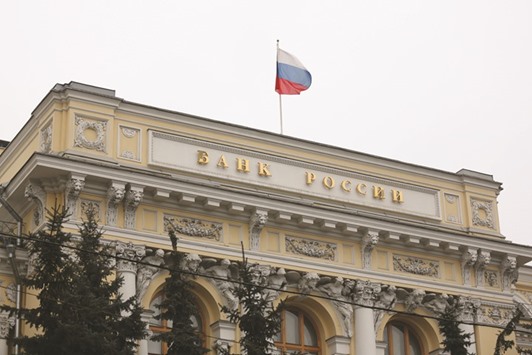Russia’s central bank stepped forward as a seller of local-currency government bonds that triggered a spike in trading as an approaching liquidity surplus prompts policy makers to drain excess roubles.
The announcement by the Bank of Russia that it sold a “limited amount” of so-called OFZ notes from its portfolio on the market in April and May ends weeks of speculation by analysts and investors after trading volumes surged. Sales may have reached as much as 100bn roubles ($1.5bn), according to Dmitry Polevoy, chief economist for Russia and the Commonwealth of Independent States at ING Group in Moscow.
“Everyone realised that there was a major seller, but nobody expected it to be the central bank,” said Evgeny Shilenkov, head of trading at Veles Capital in Moscow. “It shows policy makers are fighting excess liquidity.”
Deficit spending to reverse the second year of recession is flooding the banking system with cash as authorities tap one of Russia’s two sovereign wealth coffers to cover the widest budget gap since 2010. With central bank funding becoming less attractive for lenders - net borrowers from the regulator since 2011 - its ability to soak up liquidity is waning, presenting risks to inflation.
Operations with securities on the open market are “one of the traditional instruments of monetary policy” for central banks globally, the regulator’s press service said in an e-mailed response to questions, without disclosing the amount sold. OFZs accounted for 207bn roubles of the 512.7bn roubles of government debt held by the Bank of Russia as of January 1, according to its annual report.
The central bank’s bond sales explain the jump in OFZ trading volumes over the past few weeks, according to Polevoy. On April 28, 42bn roubles of OFZs were traded on the Moscow Exchange, the most this year.
Russia’s February 2027 bonds climbed, reducing the yield by four basis points to 8.93% and trimming the increase this month to five basis points.
“It’s a negative factor for the OFZ market that you can’t price in accurately,” Alexey Pogorelov, an economist at Credit Suisse Group in London, said by e-mail. “Our main concern was about the transparency of such operations.”
Even so, Veles Capital’s Shilenkov said OFZs have proven to be resilient in the face of central bank sales in April, and government bond prices are set to remain stable if oil and the ruble are steady. Local government bonds are the second-best performers among emerging markets this year, handing investors 15% in dollar terms through May 10, according to data compiled by Bloomberg.
“Had the central bank sold OFZs via the weekly Finance Ministry auction, they would’ve had to offer a premium,” Shilenkov said. “By selling on the market, they got a better yield.”
With Russia mired in its longest recession in two decades after oil’s collapse, the Finance Ministry is struggling to keep the budget deficit within 3% of gross domestic product this year. It channelled 2.6tn roubles from the Reserve Fund into the economy last year. In April, it injected a further 390bn roubles, or about a fifth of the plan for 2016.
The buildup of liquidity has pushed down money-market rates without any shift in monetary policy by the central bank. The overnight money-market rate known as Ruonia has averaged 10.88% this year, down from more than 17% at the start of 2015. The central bank has held its benchmark unchanged at 11% since July.
“This could signal that the central bank is concerned that a full-scale liquidity surplus is arriving and maybe overestimates inflation risks resulting from a liquidity surplus,” said Oleg Kouzmin, chief economist for Russia at Renaissance Capital in Moscow. “We think a full-scale liquidity surplus brings a 50 basis-point decline in overnight market rates, but not more than that.”
Governor Elvira Nabiullina has said the monetary authority has the tools to assert control over interest rates in the economy, including with short-term central bank bonds and by conducting deposit auctions. The shift into surplus is affecting the transmission of monetary policy and is threatening the inflation outlook, providing another reason for “acting cautiously” on rates, central bank First Deputy Governor Ksenia Yudaeva said in an interview last month.
The central bank, which overshot its target for price growth in 2015 for a fourth consecutive year, has conceded it’s at risk of missing its 4% goal in late 2017 after turmoil in the oil market and the rouble at the start of the year.

A Russian national flag flies above the headquarters of Russia’s central bank in Moscow. The Bank of Russia stepped forward as a seller of local-currency government bonds that triggered a spike in trading as an approaching liquidity surplus prompts policy makers to drain excess roubles.


